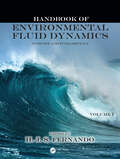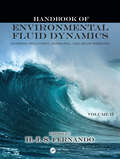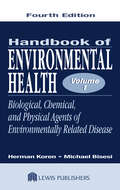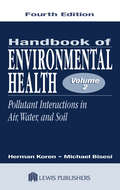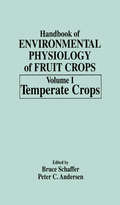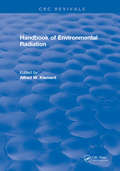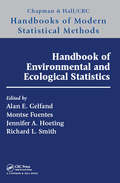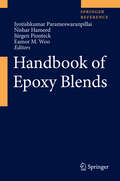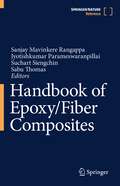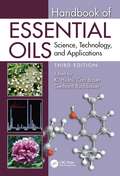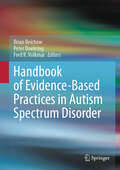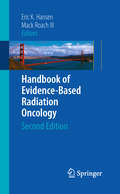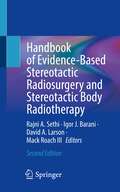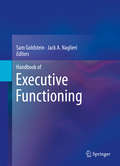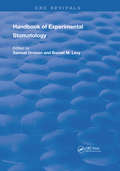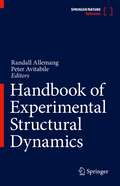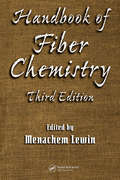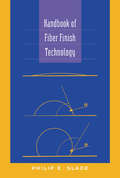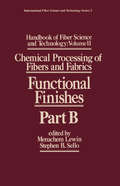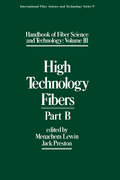- Table View
- List View
Handbook of Environmental Fluid Dynamics, Volume One: Overview and Fundamentals
by H. J. S. FernandoWith major implications for applied physics, engineering, and the natural and social sciences, the rapidly growing area of environmental fluid dynamics focuses on the interactions of human activities, environment, and fluid motion. A landmark for the field, the two-volume Handbook of Environmental Fluid Dynamics presents the basic principles, funda
Handbook of Environmental Fluid Dynamics, Volume Two: Systems, Pollution, Modeling, and Measurements
by H. J. S. FernandoWith major implications for applied physics, engineering, and the natural and social sciences, the rapidly growing area of environmental fluid dynamics focuses on the interactions of human activities, environment, and fluid motion. A landmark for the field, the two-volume Handbook of Environmental Fluid Dynamics presents the basic principles, funda
Handbook of Environmental Health, Volume I: Biological, Chemical, and Physical Agents of Environmentally Related Disease
by Michael S. Bisesi Herman KorenThe Handbook of Environmental Health-Biological, Chemical and Physical Agents of Environmentally Related Disease, Volume 1, Fourth Edition includes twelve chapters on a variety of topics basically following a standard chapter outline where applicable with the exception of chapters 1, 2 and 12. The outline is as follows:1. Background and status2. Sc
Handbook of Environmental Health, Volume II: Pollutant Interactions in Air, Water, and Soil
by Herman Koren Michael S. BisesiThe Handbook of Environmental Health-Pollutant Interactions in Air, Water, and Soil includes Nine Chapters on a variety of topics basically following a standard chapter outline where applicable with the exception of Chapters 8 and 9. The outline is as follows:1. Background and status2. Scientific, technological and general information3. Statement o
Handbook of Environmental Isotope Geochemistry
by Mark BaskaranApplications of radioactive and stable isotopes have revolutionized our understanding of the Earth and near-earth surface processes. The utility of the isotopes are ever-increasing and our sole focus is to bring out the applications of these isotopes as tracers and chronometers to a wider audience so that they can be used as powerful tools to solve environmental problems. New developments in this field remain mostly in peer-reviewed journal articles and hence our goal is to synthesize these findings for easy reference for students, faculty, regulators in governmental and non-governmental agencies, and environmental companies. While this volume maintains its rigor in terms of its depth of knowledge and quantitative information, it contains the breadth needed for wide variety problems and applications in the environmental sciences. This volume presents all of the newer and older applications of isotopes pertaining to the environmental problems in one place that is readily accessible to readers. This book not only has the depth and rigor that is needed for academia, but it has the breadth and case studies to illustrate the utility of the isotopes in a wide variety of environments (atmosphere, oceans, lakes, rivers and streams, terrestrial environments, and sub-surface environments) and serves a large audience, from students and researchers, regulators in federal, state and local governments, and environmental companies.
Handbook of Environmental Isotope Geochemistry: Vol I (Advances in Isotope Geochemistry)
by Mark BaskaranApplications of radioactive and stable isotopes have revolutionized our understanding of the Earth and near-earth surface processes. The utility of the isotopes are ever-increasing and our sole focus is to bring out the applications of these isotopes as tracers and chronometers to a wider audience so that they can be used as powerful tools to solve environmental problems. New developments in this field remain mostly in peer-reviewed journal articles and hence our goal is to synthesize these findings for easy reference for students, faculty, regulators in governmental and non-governmental agencies, and environmental companies. While this volume maintains its rigor in terms of its depth of knowledge and quantitative information, it contains the breadth needed for wide variety problems and applications in the environmental sciences. This volume presents all of the newer and older applications of isotopes pertaining to the environmental problems in one place that is readily accessible to readers. This book not only has the depth and rigor that is needed for academia, but it has the breadth and case studies to illustrate the utility of the isotopes in a wide variety of environments (atmosphere, oceans, lakes, rivers and streams, terrestrial environments, and sub-surface environments) and serves a large audience, from students and researchers, regulators in federal, state and local governments, and environmental companies.
Handbook of Environmental Physiology of Fruit Crops
by Bruce Schaffer Peter C. AndersenThese exciting new companion handbooks are the only ones of their kind devoted solely to the effects of environmental variables on the physiology of the world's major fruit and nut crops. Their cosmopolitan scope includes chapters on tropical and temperate zone species written by scientists from several continents. The influence of environmental factors, such as irradiance, temperature, water and salinity on plant physiology and on vegetative and reproductive growth, is comprehensively discussed for each crop. In addition to being a thorough and up-to-date set of textbooks, the organzation of the two volumes makes them an excellent reference tool. Each chapter focuses on a single crop, or a group of genetically or horticulturally related crop, and is appropriately divided into subsections that address individual environmental factors. Some chapters emphasize whole-plant physiology and plant growth and development, while other chapters feature theoretical aspects of plant physiology. Several chapters provide botanical background discussions to enhance understanding of the crop's response to its environment.
Handbook of Environmental Radiation
by Alfred W. KlementThe primary aim of the handbook series will be to include as much useful data as possible for the specialist needing ready access for the solution of problems most likely to arise in the radiation protection professions. However, some selected review of fundamental concepts is also included to enable persons with a basic science or engineering background to acquire the necessary knowledge to solve a majority of problems in especially important aspects of radiation protection. Also since the profession is broad in discipline, an attempt has been made to fulfil the frequent need of professionals for a refresher course in some of the more important fundamentals needed to utilize data included in the handbook. Principles of management, organization, and procedures related to radiation safety will also be summarized in later volumes, with attention to presentation of methods for establishing new radiation safety programs based on the accumulated experience of others.
Handbook of Environmental and Ecological Statistics (ISSN)
by Alan Gelfand; Montse Fuentes; Jennifer A. Hoeting; Richard L. SmithThis handbook focuses on the enormous literature applying statistical methodology and modelling to environmental and ecological processes. The 21st century statistics community has become increasingly interdisciplinary, bringing a large collection of modern tools to all areas of application in environmental processes. In addition, the environmental community has substantially increased its scope of data collection including observational data, satellite-derived data, and computer model output. The resultant impact in this latter community has been substantial; no longer are simple regression and analysis of variance methods adequate. The contribution of this handbook is to assemble a state-of-the-art view of this interface. Features: An internationally regarded editorial team. A distinguished collection of contributors. A thoroughly contemporary treatment of a substantial interdisciplinary interface. Written to engage both statisticians as well as quantitative environmental researchers. 34 chapters covering methodology, ecological processes, environmental exposure, and statistical methods in climate science.
Handbook of Epoxy Blends
by Jyotishkumar Parameswaranpillai Nishar Hameed Jürgen Pionteck Eamor M. WooThis reference work compiles and summarizes the available information on epoxy blends. It covers all essential areas - the synthesis, processing, characterization and applications of epoxy blends - in a comprehensive manner. The handbook is highly application-oriented and thus serves as a valuable, authoritative reference guide for researchers, engineers, and technologists working on epoxy blends, but also for graduate and postgraduate students, polymer chemists, and faculties at universities and colleges. The handbook is divided into three parts and organized by the types of blends and components: Part I covers epoxy rubber blends, Part II focuses on epoxy thermoplastic blends, and Part III examines epoxy block-copolymer blends. Each part starts with an introduction, and the individual chapters provide readers with comprehensive information on the synthesis and processing, analysis and characterization, properties and applications of the different epoxy blends. All parts conclude with a critical evaluation of the applications, weighing their advantages and drawbacks. Leading international experts from corporate and academic research institutions and universities discuss the correlations of different epoxy blend properties with their macro-, micro- and nanostructures. This handbook thus offers a rich resource for newcomers to the field, and a major reference work for experienced researchers, the first of its kind available on the market. As epoxies find extremely broad applications, e. g. in oil & gas, in the chemical industry, building and construction industry, automotive, aviation and aerospace, boat building and marine applications, in adhesives and coatings, and many more, this handbook addresses researchers and practitioners from all these fields.
Handbook of Epoxy/Fiber Composites
by Sabu Thomas Jyotishkumar Parameswaranpillai Suchart Siengchin Sanjay Mavinkere RangappaThis handbook presents the current state-of-knowledge in the area of epoxy fiber composites. The book emphasizes new challenges and covers synthesis, characterization, and applications of epoxy/fiber composites. Leading researchers from industry, academy, government and private research institutions across the globe have contributed to this book. The contents comprehensively cover the current status, trends, future directions, and application opportunities in the field. This highly application-oriented handbook will be of use to researchers and professionals alike.
Handbook of Essential Oils: Science, Technology, and Applications
by K. Hüsnü Can Başer and Gerhard BuchbauerHandbook of Essential Oils: Science, Technology, and Applications presents the development, use and marketing of essential oils. Exciting new topics include insecticidal applications, but there is a continued focus on the chemistry, pharmacology and biological activities of essential oils. The third edition unveils new chapters including the insect repellent and insecticidal activities of essential oils, the synergistic activity with antibiotics against resistant microorganisms, essential oil applications in agriculture, plant-insect interactions, and pheromones and contaminants in essential oils. Features Presents a wide range of topics including sources, production, analysis, storage, transport, chemistry, aromatherapy, pharmacology, toxicology, metabolism, technology, biotransformation, application, utilization, and trade Includes discussions of biological activity testing, results of antimicrobial and antioxidant tests, and penetration enhancing activities useful in drug delivery Covers up-to-date regulations and legislative procedures, together with the use of essential oils in perfumes, cosmetics, feed, food, beverages, and pharmaceutical industries Unveils new chapters including the insect repellent and insecticidal activities of essential oils, the synergistic activity with antibiotics against resistant microorganisms, essential oil applications in agriculture, plant-insect interactions, and pheromones and contaminants in essential oils The American Botanical Council (ABC) named the second edition as the recipient of the 2016 ABC James A. Duke Excellence in Botanical Literature Award and recognized that essential oils are one of the fastest growing segments of the herbal product market
Handbook of Evidence-Based Practices in Autism Spectrum Disorder
by Fred R. Volkmar Peter Doehring Brian ReichowThe handbook examines the empirical status of interventions and treatments for individuals with autism spectrum disorder (ASD). It offers an insightful and balanced perspective on topics ranging from the historical underpinnings of autism treatment to the use of psychopharmacology and the implementation of EBPs. The book reviews the conceptualization of evidence-based practices (EBPs) as well as considerations for implementing such practices across settings. In addition, it describes emerging treatments – though they cannot yet be considered evidence-based – that have produced limited but highly promising results. The book also describes treatments and therapies that have been proved ineffective. It explores ways in which EBPs can be applied in inclusive school settings, pedatric settings, in-patient treatment progams, and college-based programs for transition-aged youth. The volume describes outcomes from the development of EBP guidelines at the national level (in Scotland) and, more broadly, in the United States and outlines how such guidelines can be adapted to offer more individualized intervention. Key areas of coverage include: Comprehensive treatment models, including early intensive behavioral intervention, pivotal response treatment, Early Start Denver Model, and Naturalistic Developmental Behavioral Interventions. Focal treatments addressing the core deficits of ASD and its co-occuring conditions. Social skills, communication, and the use of applied behavior analysis (ABA) practices for teaching new skills and decreasing challenging behaviors. Sensory-based interventions, psychopharmacology, cognitive behavior therapy, and parent education programs (e.g., Project ImPACT). The Handbook of Evidence-Based Practices in Autism Spectrum Disorder is an invaluable resource for researchers, professors, and graduate students as well as clinicians, therapists, and all professionals working in the fields of developmental, clinical child, and school psychology, pediatrics, social work, behavior analysis, allied health sciences, public health, child and adolescent psychiatry, early childhood intervention, and general and special education.
Handbook of Evidence-Based Radiation Oncology
by Mack Roach III Eric HansenBuilding on the success of this book's first edition, Dr. Eric Hansen and Dr. Mack Roach have updated, revised, and expanded the Handbook of Evidence-based Radiation Oncology, a portable reference that utilizes evidence-based medicine as the basis for practical treatment recommendations and guidelines. Organized by body site, concise clinical chapters provide easy access to critical information. Important "pearls" of epidemiology, anatomy, pathology, and clinical presentation are highlighted. Key facets of the work-up are listed, followed by staging and/or risk classification systems. Treatment recommendations are discussed based on stage, histology, and/or risk classification. Brief summaries of key trials and studies provide rationale for the recommendations. Practical guidelines for radiation techniques are described. Finally, complications and follow-up guidelines are outlined. Updates from the first edition include brand new color figures and color contouring mini-atlases for head and neck, gastrointestinal, prostate, and gynecological tumors; redesigned tables for increased readability; new chapters on management of the neck and unknown primary, clinical radiobiology, and pediatric malignancies and benign conditions; and new appendices including the American College of Radiology guidelines for administration of IV contrast.
Handbook of Evidence-Based Stereotactic Radiosurgery and Stereotactic Body Radiotherapy
by Mack Roach III Rajni A. Sethi Igor J. Barani David A. LarsonThis handbook concisely summarizes state-of-the-art information about stereotactic radiosurgery (SRS) and stereotactic body radiotherapy (SBRT), including the history and development of these modalities, the biologic rationale for these technologies, typical practices, and reported results. Developed as a companion to Handbook of Evidence-Based Radiation Oncology, edited by Eric Hansen and Mack Roach, III, it is organized by disease site and presents treatment techniques and recommended imaging; safety and quality assurance; toxicities and management; recommended follow-up; and supporting evidence. Inclusion of evidence-based guidelines is intended to help inform decisions regarding the appropriateness of SRS and SBRT and guide treatment and evaluation. This new edition is fully updated with the latest literature. A new chapter on dose constraints has also been added, along with additional content on SBRT for oligometastatic disease and prostate, and the integration of SBRT with systemic therapy, including chemotherapy, immunotherapy, targeted agents. Case examples are added, as well as additional images to highlight situations described. Handbook of Evidence-Based Stereotactic Radiosurgery and Stereotactic Body Radiotherapy, 2e can be easily referenced in the clinic and is a valuable guide for radiation oncology practitioners
Handbook of Evolutionary Machine Learning (Genetic and Evolutionary Computation)
by Penousal Machado Mengjie Zhang Wolfgang BanzhafThis book, written by leading international researchers of evolutionary approaches to machine learning, explores various ways evolution can address machine learning problems and improve current methods of machine learning. Topics in this book are organized into five parts. The first part introduces some fundamental concepts and overviews of evolutionary approaches to the three different classes of learning employed in machine learning. The second addresses the use of evolutionary computation as a machine learning technique describing methodologic improvements for evolutionary clustering, classification, regression, and ensemble learning. The third part explores the connection between evolution and neural networks, in particular the connection to deep learning, generative and adversarial models as well as the exciting potential of evolution with large language models. The fourth part focuses on the use of evolutionary computation for supporting machine learning methods. This includes methodological developments for evolutionary data preparation, model parametrization, design, and validation. The final part covers several chapters on applications in medicine, robotics, science, finance, and other disciplines. Readers find reviews of application areas and can discover large-scale, real-world applications of evolutionary machine learning to a variety of problem domains. This book will serve as an essential reference for researchers, postgraduate students, practitioners in industry and all those interested in evolutionary approaches to machine learning.
Handbook of Exact Solutions to Mathematical Equations (ISSN)
by Andrei D. PolyaninThis reference book describes the exact solutions of the following types of mathematical equations:● Algebraic and Transcendental Equations ● Ordinary Differential Equations ● Systems of Ordinary Differential Equations ● First-Order Partial Differential Equations ● Linear Equations and Problems of Mathematical Physics ● Nonlinear Equations of Mathematical Physics ● Systems of Partial Differential Equations ● Integral Equations ● Difference and Functional Equations ● Ordinary Functional Differential Equations ● Partial Functional Differential EquationsThe book delves into equations that find practical applications in a wide array of natural and engineering sciences, including the theory of heat and mass transfer, wave theory, hydrodynamics, gas dynamics, combustion theory, elasticity theory, general mechanics, theoretical physics, nonlinear optics, biology, chemical engineering sciences, ecology, and more. Most of these equations are of a reasonably general form and dependent on free parameters or arbitrary functions.The Handbook of Exact Solutions to Mathematical Equations generally has no analogs in world literature and contains a vast amount of new material. The exact solutions given in the book, being rigorous mathematical standards, can be used as test problems to assess the accuracy and verify the adequacy of various numerical and approximate analytical methods for solving mathematical equations, as well as to check and compare the effectiveness of exact analytical methods.
Handbook of Executive Functioning
by Sam Goldstein Jack A. NaglieriPlanning. Attention. Memory. Self-regulation. These and other core cognitive and behavioral operations of daily life comprise what we know as executive functioning (EF). But despite all we know, the concept has engendered multiple, often conflicting definitions and its components are sometimes loosely defined and poorly understood. The Handbook of Executive Functioning cuts through the confusion, analyzing both the whole and its parts in comprehensive, practical detail for scholar and clinician alike. Background chapters examine influential models of EF, tour the brain geography of the executive system and pose salient developmental questions. A section on practical implications relates early deficits in executive functioning to ADD and other disorders in children and considers autism and later-life dementias from an EF standpoint. Further chapters weigh the merits of widely used instruments for assessing executive functioning and review interventions for its enhancement, with special emphasis on children and adolescents. Featured in the Handbook: The development of hot and cool executive function in childhood and adolescence. A review of the use of executive function tasks in externalizing and internalizing disorders. Executive functioning as a mediator of age-related cognitive decline in adults. Treatment integrity in interventions that target executive function. Supporting and strengthening working memory in the classroom to enhance executive functioning. The Handbook of Executive Functioning is an essential resource for researchers, scientist-practitioners and graduate students in clinical child, school and educational psychology; child and adolescent psychiatry; neurobiology; developmental psychology; rehabilitation medicine/therapy and social work.
Handbook of Experimental Stomatology (Routledge Revivals)
by Samuel Dreizen, D.D.S., M.D., Barnet M. Levy, D.D.S., M.S. and Barnet M. LevyFirst Published in 1981, this book offers a full, comprehensive guide to experimental stomatology. Carefully compiled and filled with a vast repertoire of notes, diagrams, and references this book serves as a useful reference for students of medicine, and other practitioners in their respective fields.
Handbook of Experimental Structural Dynamics
by Randall Allemang Peter AvitabileThe SEM Handbook of Experimental Structural Dynamics stands as a comprehensive overview and reference for its subject, applicable to workers in research, product design and manufacture, and practice. The Handbook is devoted primarily to the areas of structural mechanics served by the Society for Experimental Mechanics IMAC community, such as modal analysis, rotating machinery, structural health monitoring, shock and vibration, sensors and instrumentation, aeroelasticity, ground testing, finite element techniques, model updating, sensitivity analysis, verification and validation, experimental dynamics sub-structuring, quantification of margin and uncertainty, and testing of civil infrastructure. Chapters offer comprehensive, detailed coverage of decades of scientific and technologic advance and all demonstrate an experimental perspective. Several sections specifically discuss the various types of experimental testing and common practices utilized in the automotive, aerospace, and civil structures industries. · History of Experimental Structural Mechanics · DIC Methods - Dynamic Photogrammetry · LDV Methods · Applied Digital Signal Processing · Introduction to Spectral - Basic Measurements · Structural Measurements - FRF · Random and Shock Testing · Rotating System Analysis Methods · Sensors Signal Conditioning Instrumentation · Design of Modal Tests · Experimental Modal Methods · Experimental Modal Parameter Evaluation · Operating Modal Analysis Methods · Analytical Numerical Substructuring · Finite Element Model Correlation · Model Updating · Damping of Materials and Structures · Model Calibration and Validation in Structures · Uncertainty Quantification: UQ, QMU and Statistics · Nonlinear System Analysis Methods (Experimental) · Structural Health Monitoring and Damage Detection · Experimental Substructure Modeling · Modal Modeling · Response (Impedance) Modeling · Nonlinear Normal Mode Analysis Techniques (Analytical) · Modal Modeling with Nonlinear Connection Elements (Analytical) · Acoustics of Structural Systems (VibroAcoustics) · Automotive Structural Testing · Civil Structural Testing · Aerospace Perspective for Modeling and Validation · Sports Equipment Testing · Applied Math for Exper
Handbook of Face Recognition
by Stan Z. Li Anil K. Jain Jiankang DengThe history of computer-aided face recognition dates to the 1960s, yet the problem of automatic face recognition – a task that humans perform routinely and effortlessly in our daily lives – still poses great challenges, especially in unconstrained conditions.This highly anticipated new edition provides a comprehensive account of face recognition research and technology, spanning the full range of topics needed for designing operational recognition systems. After a thorough introduction, each subsequent chapter focuses on a specific topic, reviewing background information, up-to-date techniques, and recent results, as well as offering challenges and future directions.Topics and features:Fully updated, revised, and expanded, covering the entire spectrum of concepts, methods, and algorithms for automated detection and recognition systemsProvides comprehensive coverage of face detection, alignment, feature extraction, and recognition technologies, and issues in evaluation, systems, security, and applicationsContains numerous step-by-step algorithmsDescribes a broad range of applications from person verification, surveillance, and security, to entertainmentPresents contributions from an international selection of preeminent expertsIntegrates numerous supporting graphs, tables, charts, and performance dataThis practical and authoritative reference is an essential resource for researchers, professionals and students involved in image processing, computer vision, biometrics, security, Internet, mobile devices, human-computer interface, E-services, computer graphics and animation, and the computer game industry.
Handbook of Fiber Chemistry (International Fiber Science and Technology)
by Menachem LewinThe Handbook of Fiber Chemistry, Third Edition provides complete coverage of scientific and technological principles for all major natural and synthetic fibers. Incorporating new scientific techniques, instruments, characterization, and processing methods, the book features important technological advances from the past decade, particularly
Handbook of Fiber Finish Technology
by Philip E. SladeDiscusses the components of textile finishes, and the chemical and physical properties of, as well as their effects on, various fibres. The book covers fundamentals of fibre finish science, such as theories of friction; laboratory testing of formulations, from preliminary component evaluation to analyses for material characterization; and the influence of wetting, emulsification and finish distribution on coatings.
Handbook of Fiber Science and Technology Volume 2: Chemical Processing of Fibers and Fabrics-- Functional Finishes Part B
by Menachem Lewin and Stephen B. SelloContinuing the outstanding coverage from Part A, the authoritative information inFunctional Finishes, Part B makes your work with fibers and fabrics cost-effective ...offers practical guidance in finishing techniques-including flame retardancy, water andoil repellency, soil release, electroconductivity, and radiation ... and eases your continuingstudy of this expanding field with numerous, current references-with manyoriginal findings not previously cited.As new advances widen the scope of this field, each volume of Handbook of Fiber Scienceand Technology becomes an indispensable acquisition for researchers. Textile ,fiber, polymer, organic, physical, and biological chemists; textile finishers and chemicalmanufacturers; R & D personnel in the polymer, fiber, chemical, and textile industries;plastics and chemical engineers; materials scientists; and wood and paper technologistswill find them essential references. They are also superior sources of supplementaryreading for graduate and advanced undergraduate courses in polymer, fiber, and textilechemistry and technology ; chemical processing of fibers, chemical technology andengineering, and polymer processing.
Handbook of Fiber Science and Technology Volume 2: High Technology Fibers: Part B (International Fiber Science And Technology Ser. #9)
by Menachem Lewin Jack PrestonMaintaining the high standards set in Part A, this important reference brings you the mostcomprehensive, up-to-date coverage of both recently developed and potentially available fibersfor applications outside the textile industry.Emphasizing practical industrial applications and future research directions for high technologyfibers , Handbook of Fiber Science and Technology: Volume III, Part B sharesresearch developments in high-modulus fibers from organic polymers or inorganic materials... discusses how to predict applications for aramid fibers based upon structure/propertyrelationships .. . sets forth fundamental principles for spinning polymers to fibers . ..reviews the underlying science and technology of fibers derived from thennotropic copolyesters... and more.
